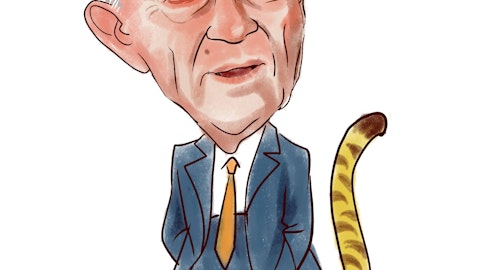Josh Nichols: Thanks and then just one or two small things. Shig, did you mention, I think you said product revenue would be between 3.8 million and 4.1million for fourth quarter?
Shig Hamamatsu: That’s correct.
Josh Nichols: So it’s kind of in line. And then last question, I know that there’s like a big delta between the GAAP and the non-GAAP guidance for 4Q. I know that that’s not super surprising given the acquisition. I was just kind of curious what you were expecting for one-time cost, just trying to think about how to manage or model the cash flow for 4Q?
Shig Hamamatsu: Yes, so the fourth quarter, we are going to have a few onetime costs. So one item is a restructuring cost, restructuring activities we undertook has cost associated with it. It’s in press release, Josh. It’s 0.5 million, that we’re incurring there in Q4. And we also have some additional acquisition related costs. But we can get, it’s actually press release — in the press release too, and happy to get you little more detail there.
Operator: Our next question comes from the line of Brian Kinstlinger with Alliance Global Partners. Your line is now open.
Brian Kinstlinger: Congrats about success with AirDial. My one question is, last quarter you talked about there were challenges in the pace of installation, some of it were people, some of it were the various places, where installs might happen. What progress has the Company made especially within its control, the pieces under its control, if any to help improved installation rates? Thank you.
Eric Stang: Yes. Hi, Brian. I feel we have got that well in hand actually. We have a customer right now, who wanted to roll out to quite significant number of locations, and do it all in a week. And we did it. And so when a customer is ready to move and if the customer knows what their needs are and where their needs are, and has the access and all that planned out, we can move quickly with them. We are — not all our customers are like that. Some customers can take several months just to even stand up a proof-of-concept and test something for then a couple of months more. But sometimes you get customers, who have a deadline and they want to move. So I feel like, the pace of rollout is being driven more from what customers can accomplish than our team. We are ready to go.
Brian Kinstlinger: I guess my second question for Shig would be when the installations start ramping and they become a more meaningful piece of revenue, just remind us the puts and takes to product revenue and margin versus subscription and services?
Shig Hamamatsu: Yes. So, as the installation lands, Brian, so we are reporting cost and revenue related to installation activity itself in a product along with a product, itself. And so, we are going to start to see that product revenue increase, as we ramp on the installation. And I think we talked about earlier, but our intent is to, not lose money on the installation activities, meaning that we passed on a cost to customer, to achieve that And so, my take on that is, as we have more AirDial-related product installation revenue, product margin should improve as well over time. Obviously, that would precede the ramp on the subscription revenue related to AirDial because installation needs to happen in front of it. And we are still seeing a pretty good trend on AirDial ARPU on the service side. And we think it is going to be accretive to our subscription margin today as we ramp on the subscription side as well.
Operator: [Operator Instructions] Our next question comes from the line of Matthew Harrigan with Benchmark. Your line is now open.
Matthew Harrigan: Firstly, since you are not including 2600Hz in your KPIs, and it is pretty evident we are going to be modeling that in the longer-term. You talked about some of the growth opportunities there with some of the customized apps and certainly even better monetization of Kazoo. What’s your ambition in terms of the long term growth rate there, which would presumably exceed that for your core business? And then secondly, on your existing subscription business, you said that 28% are taking Pro or Pro Plus right now, I mean, you’ve got a good product incrementally at pretty low incremental cost. Why is it? And I know I’ve asked you this before, but how often — do you consider devoting more to marketing to upgrade the installed base?
I don’t know whether it’s much more of a brotherly shove than looks like on the surface to get people to upgrade, but presumably you could be affording more utility for your customers and ramping up your growth rate while you do it at the same time.
Eric Stang: Well, we do a bit of outreach towards our existing customer base around Pro and Pro Plus. You got to keep in mind that when they came on board as users, they self-selected at the time with our solution so that they’re pretty happy with what they’ve got many of those users. In some cases, it’s hard to reach out to them too because marketing emails don’t always get to flow through. But we do see customers as they expand starting to tap into some of our new capabilities, and as I said, the new customers coming on board coming on more than half of them are taking a premium tier. We — it might be part of it a little bit might be too just you really need to explain it to customers. And our salespeople are able to do that with the new customer. It’s a little bit hard to have those conversations at that level with our installed base. But that’s something we work on and we can devote more resources to you going forward. First question again.
Matthew Harrigan: Would there be any way to do a sort of a push free trial for like a month or three months to just show them the capabilities? I assume the expenses wouldn’t be that high to do it. Or is that’s just awkward in terms of the software upgrade?
Eric Stang: No, we do different kinds of things sometimes more or less of that nature. Yes, it’s a good question and what we tend to do today is just send emails with a little bit information of some of the features that people could get. But free trials aren’t a bad way to go either. And keep that in mind.
Shig Hamamatsu: I think Matt, your first question was something along the line of with respect to 2600Hz, what sort of growth rate that you could assume in relation to the core business or something like that.
Matthew Harrigan: That’s exactly because it’s pretty — I’m too far going to be modeling that separately since you’re not including that in your core KPIs as you stipulated.



